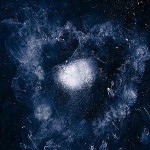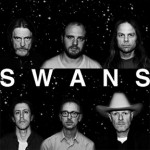
BY ALTUĞ KARAKURT (EE/III)
altug.karakurt@ug.bilkent.edu.tr
Last Saturday, I had the chance to see one of my recent favorite bands. Swans is an experimental post-punk/noise rock band from New York. The band was first founded in 1982 and released 10 albums between then and 1997. After a 13-year long hiatus, they reunited in 2010 and since then, have been releasing one masterpiece after another.
Swans’ style is quite difficult to describe, since they always go for the most unexpected and unfamiliar song structures. In addition to the standard rock outfit, the band uses keyboards, lap steel guitar with eBow and a very large set of percussion instruments in their ordinary setup; they occasionally employ clarinet, brass instruments, dulcimer and synths.
 Swans has an extremely repetitive, tense, layered sound. Despite their minimalist approach, the band manages to create rich, profound and diverse sonic sculptures. In a Swans piece, it’s common to hear distorted guitars playing the same chord over and over again for minutes, building up the tension. After a while, the listener goes numb to the repeated guitar riffs and drifts into the progressions of the other instruments in the background, surrounded by the tension and the dark atmosphere of the guitars. With the hypnotic sound of the lap guitars, the mesmerizing percussion and the groovy bass sections, I often feel like I’m floating in a sea of sound while listening to their records. It gets very difficult to keep track of the individual sections and compositional details, but they manage to carve their emotional impact into the listener’s ears. The key to the intensity of their sound is the band’s success in imposing a feeling of volume and blending the sounds such that the instruments create what seems to be a single complex sound instead of a combination of sounds produced by distinct instruments.
Swans has an extremely repetitive, tense, layered sound. Despite their minimalist approach, the band manages to create rich, profound and diverse sonic sculptures. In a Swans piece, it’s common to hear distorted guitars playing the same chord over and over again for minutes, building up the tension. After a while, the listener goes numb to the repeated guitar riffs and drifts into the progressions of the other instruments in the background, surrounded by the tension and the dark atmosphere of the guitars. With the hypnotic sound of the lap guitars, the mesmerizing percussion and the groovy bass sections, I often feel like I’m floating in a sea of sound while listening to their records. It gets very difficult to keep track of the individual sections and compositional details, but they manage to carve their emotional impact into the listener’s ears. The key to the intensity of their sound is the band’s success in imposing a feeling of volume and blending the sounds such that the instruments create what seems to be a single complex sound instead of a combination of sounds produced by distinct instruments.
In 2010, Swans announced they were reuniting, and “My Father Will Guide Me a Rope to the Sky” was released at the end of the same year. I find this to be one of the most interesting transition albums out there. The old Swans sound is very discernable, but due to the long breakup, their sound has at the same time clearly evolved. The majority of the lineup consists of the band’s former members from different periods, which makes the transformation of their artistic expression even more interesting to examine.
 The follow-up came two years later with “The Seer,” which is one of the most creative, dark and disturbing albums I have heard to this point. It is on this record where the band finalizes its new, post-hiatus era sound and sets the bar as high as in their earlier masterpieces from the ’90s, such as “Soundtracks for the Blind” and “The Great Annihilator.” The intense sound carries one through the album with some of the tensest Swans compositions to date. For me, “The Seer” is a milestone in the band’s discography, hinting that the old Swans sound has transformed into a much more mature, atmospheric and extremely dark one. This record has had a very positive reception and boosted the expectations of longtime fans, while introducing Swans to a much larger young audience than before.
The follow-up came two years later with “The Seer,” which is one of the most creative, dark and disturbing albums I have heard to this point. It is on this record where the band finalizes its new, post-hiatus era sound and sets the bar as high as in their earlier masterpieces from the ’90s, such as “Soundtracks for the Blind” and “The Great Annihilator.” The intense sound carries one through the album with some of the tensest Swans compositions to date. For me, “The Seer” is a milestone in the band’s discography, hinting that the old Swans sound has transformed into a much more mature, atmospheric and extremely dark one. This record has had a very positive reception and boosted the expectations of longtime fans, while introducing Swans to a much larger young audience than before.
Last May, the band released their latest album (and my absolute favorite of theirs), “To Be Kind.” This record features the most skillfully crafted Swans pieces so far. With an amazing, groovy contribution from the bass, the band’s repetitive, intense compositions are here favored with fantastic musicianship and crystal-clear production. This album not only softens the tension, but shows that Swans is capable of discovering new musical identities and delivering new, unique creations, even in late career. I am expecting the band’s upcoming releases to go in the same direction as their two previous ones.
 Before going to the concert, I listened to these three albums over and over again. The latter two in particular get even better with a few listens, revealing the fine details of their sound textures and enabling the listener to better grasp the blended compositions. The Swans’ live performances, on the other hand, are much different than their studio recordings. They rarely play a song exactly as is, preferring instead to merge songs and play medleys or improvise on their existing songs and create new pieces. So, I was aware that this would not be just any ordinary rock concert, where a band goes out and plays their popular songs; it would be much deeper than that.
Before going to the concert, I listened to these three albums over and over again. The latter two in particular get even better with a few listens, revealing the fine details of their sound textures and enabling the listener to better grasp the blended compositions. The Swans’ live performances, on the other hand, are much different than their studio recordings. They rarely play a song exactly as is, preferring instead to merge songs and play medleys or improvise on their existing songs and create new pieces. So, I was aware that this would not be just any ordinary rock concert, where a band goes out and plays their popular songs; it would be much deeper than that.
With the help of the great atmosphere of Salon İKSV, the concert turned out to be even better than I had expected. This was the loudest performance I have ever been to, filled with eerie steel lap guitars, cymbals and blasting distorted guitar leads. Michael Gira, the founder, frontman and brain of band, conducted the entire performance with great expertise. All the other members followed his signals indicating how to adjust their tempo and tone, as well as when to repeat or change a section. The pieces that were performed resembled the recorded versions only to a point; they often sounded more like new songs, making the concert a truly unique experience.
